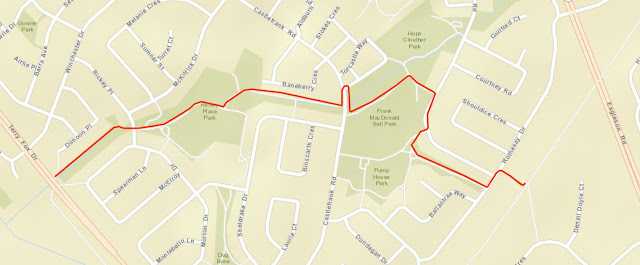Submission to The National Capital Commission
Richard W. Woodley
Bridlewood, Kanata, Ontario
June 21, 2013
I am providing this submission to the National Capital Commission (NCC) because I see the NCC as the Guardian of the Greenbelt while I see the City of Ottawa more as the guardian of roads and car drivers.
Information on this proposal and study is available on the City of Ottawa website here:
http://ottawa.ca/en/kanata-south-terry-fox-west-hunt-club-road-class-environmental-assessment-study
This proposal is in response to the perceived needs of Bridlewood residents for more roads to take private automobiles downtown during rush hours, the same time as the public transit system is optimized for. It relates more to a desire to use private automobiles with less inconvenience of time delays than a real need to improve transportation links downtown, which could be better done by improving public transit options.
The original proposal to solve this perceived problem was to, essentially, extend Terry Fox Drive to the 416 by extending Hope Side Road, which it connects directly to (essentially the same road with only the name changing), through the Greenbelt to the 416.
Apparently, according to the City, everybody agrees that that would be environmentally inappropriate, although I suspect the City simply realized that the NCC would not approve that so they decided they might as well jump on the environmental bandwagon.
So now we have a “compromise” proposal to widen and realign Old Richmond Road and West Hunt Club Road between Hope Side Road and the 416. While perhaps not as draconian as the original proposal for a new road through the Greenbelt, this new proposal still compromises the integrity of the Greenbelt by widening the road corridor through it and purposely increasing traffic through it and thus increasing the risk to wildlife and degrading their habitat.
And the reason it is proposed to do this is to reduce the inconvenience to Bridlewood car drivers during rush hour, the majority of whom could very effectively use the public transit system that is optimized for that time period. A much more effective solution would be to improve the public transit service to deal with any projected needs for more transportation capacity to downtown.
But this is really not about need but the desire of people to use private automobiles, many of them with only the driver in them, during rush hour.
I would urge the NCC to not rubber stamp this proposal from the City but to take their responsibility as Guardians of the Greenbelt and protectors of the wildlife and habitat within it very seriously before approving a proposal based on desire rather than need.
The NCC should also only consider the option that has the least impact on wildlife and it's habitat, the three lane, rather than four lane, proposal.
And finally I wish to draw to the attention of the NCC, although I am certain it is already aware of this, that along this route proposed for widening there are two NCC parking lots, P6 and P11 with trail systems on both sides where crossing from one side to the other is already very difficult and dangerous. If any widening of these roads is allowed the NCC must insist that it include a solution that provides safe passage between the trail systems on both sides of the roads at the locations of those parking lots.
Respectfully submitted
Richard W. Woodley
This submission is also being sent to:
Angela Taylor, P Eng.
Senior Project Engineer
Transportation Planning Branch
Planning & Growth Management Department
City of Ottawa
Angela.Taylor@ottawa.ca
Valerie McGirr, P. Eng.
Consultant Project Manager
AECOM
valerie.mcgirr@aecom.com
Ottawa City Councillor Allan Hubley
Ward 23 Kanata South
Allan.Hubley@ottawa.ca
This submission is also being published on my blog The Fifth Column
http://the5thc.blogspot.ca





























